 |
Minerals from Pakistan |
|
Gem mineral occurrences |
|
How these minerals form? why are they so rare?

Main occurrences and
origin
Pegmatites
The most important and
well known occurrence for gem minerals are pegmatites. 
 This kind of rocks typically forms lenses or elongated veins in granites and
gneiss. In outcrop these rocks are easily detectable, being white or very clear
and evident in the granite masses in which they are intruded. The white color is
due to the composition, mainly coarse-grained quartz, feldspars and plagioclases
with mica, tourmalines and other minor accessoires. The pegmatites are typical of the late stages of crystalisation of the intrusive rocks
. Granite pegmatites
are the most important source of gems.
This kind of rocks typically forms lenses or elongated veins in granites and
gneiss. In outcrop these rocks are easily detectable, being white or very clear
and evident in the granite masses in which they are intruded. The white color is
due to the composition, mainly coarse-grained quartz, feldspars and plagioclases
with mica, tourmalines and other minor accessoires. The pegmatites are typical of the late stages of crystalisation of the intrusive rocks
. Granite pegmatites
are the most important source of gems.
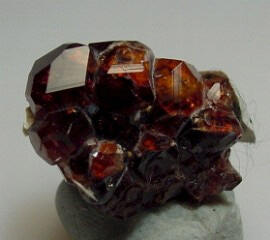 Pegmatites are quite widespread,
being associated with granites, but perhaps the most famous countries
and sources of gem minerals for collection are Brazil and Pakistan-Afghanistan.
Especially the Pakistan specimens, that became to be on the market since the
seventies, are probably the best in terms of elegance and of richness of
paragenesis. Anyway, despite of the origin, the gem minerals in pegmatites are probably the most aesthetic group of minerals
because the
Pegmatites are quite widespread,
being associated with granites, but perhaps the most famous countries
and sources of gem minerals for collection are Brazil and Pakistan-Afghanistan.
Especially the Pakistan specimens, that became to be on the market since the
seventies, are probably the best in terms of elegance and of richness of
paragenesis. Anyway, despite of the origin, the gem minerals in pegmatites are probably the most aesthetic group of minerals
because the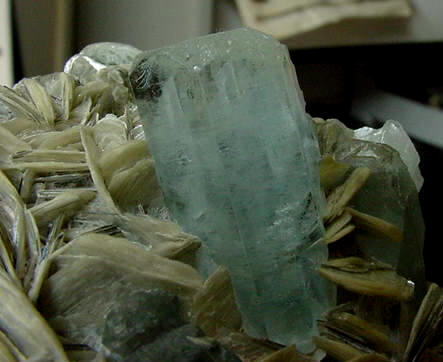 crystals are normally large and clean, due to the large
dimensions of the cavities in the
pegmatites, to the slow rate of crystalisation and the high fluid content in
these late stages of crystalisation. Moreover, they are very rich in rare elements like Be, Li,
B, Mn, P, F , important constituent for the gem minerals like Aqua., Beryl, Tourmaline, Chrysoberyl, Topaz,
Garnet,
Kunzite, and many other less common minerals.
crystals are normally large and clean, due to the large
dimensions of the cavities in the
pegmatites, to the slow rate of crystalisation and the high fluid content in
these late stages of crystalisation. Moreover, they are very rich in rare elements like Be, Li,
B, Mn, P, F , important constituent for the gem minerals like Aqua., Beryl, Tourmaline, Chrysoberyl, Topaz,
Garnet,
Kunzite, and many other less common minerals.
Placers
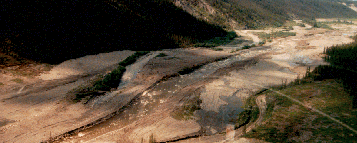 Placers
are the most common source of gems for jeweler, due to the low cost of the
mining activity and to the relative accessibility of the accumulations. Placers
are typically deposited by rivers and the concentration of gems or other
precious minerals ( typically gold ) are due to the different specific gravity
of these minerals respect to quartz or lithic grains that constitute the main
part of the transported sediments. Clearly the placers are formed by
weathering of original gem-bearing rocks.
Placers
are the most common source of gems for jeweler, due to the low cost of the
mining activity and to the relative accessibility of the accumulations. Placers
are typically deposited by rivers and the concentration of gems or other
precious minerals ( typically gold ) are due to the different specific gravity
of these minerals respect to quartz or lithic grains that constitute the main
part of the transported sediments. Clearly the placers are formed by
weathering of original gem-bearing rocks.
Other origins for gem minerals
Despite the fact that generally the gem minerals are formed in conditions of very high temperature and pressure and generally by rare elements, there some precious or semi-precious minerals that form in ambient conditions. Normally their formation is due to the action of leaching waters with reprecipitation processes
The carbonic acid
from rainwater dissolution of limestone combined with the presence of metal cations (from
volcanic rocks or from mineral veins) can give Turquoise(CuAl
6(PO 4)(OH)8, Malachite (CuCO 3 ), Rhodochrosite (MnCO 3 )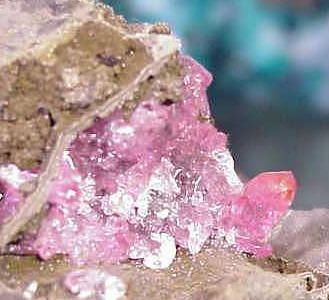
A very particular and interesting mineral is Opal. This mineral is due to the
combination of quartz with water, that gives to the mineral a particular
iridescence, very aesthetic and nice. The mineral forms in arid regions in
presence of silica, typically sandstones or volcanic rocks. It formation
requires fluctuations of the underground water table . The silica is carried in solution by groundwater
that then in the arid period is oversaturated in silica due to evaporation,
producing a Si-gel, constituted by quartz ( SiO 2 ) with molecules of water.
With further fluctuations of the water table and further evaporation, the gel
hardens and forms opal.
Hydrotermal processes
Low temperature hydrothermal processes.
This kind of process forms
in practise almost all the amethyst and the agates . The groundwater is heated
by magmatic precesses or by other reasons and became more reactive and more
leaching. The heating from the bottom and the cooling from the top
 activate convective circulations. The agates and the amethyst typically are found in
cavities of the volcanic rocks, called geodes. In this case the hosting rock fournishes the source of the mineral and the cavities for its precipitation.
activate convective circulations. The agates and the amethyst typically are found in
cavities of the volcanic rocks, called geodes. In this case the hosting rock fournishes the source of the mineral and the cavities for its precipitation.
High temperature Hydrothermal processes
They are derived from from
hot, mineral-rich, solutions from a cooling body of magma and mix with groundwater.
These solutions are very rich in Si and rare volatile elements ( Be, F, Cl ) .
In their movement to the surface, the temperature and the pressure decrease to
led to the precipitation of the solutions, genetating quartz rich veins with Emeralds, Amethyst, Imperial Topaz and precious
metals ( gold, platinum ) .
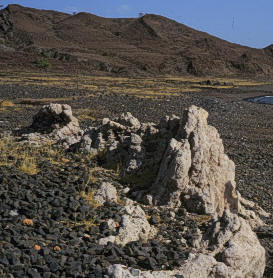
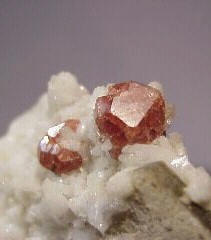 Gems
related to volcanic rocks
Gems
related to volcanic rocks
The volcanics rocks aren't
so rich in gem minerals, but probably the most important gem is related to this
environment. The kimberlites, rocks formed from magma at extremely high depth
are the rocks in which the diamonds form. Also garnets, zircon, peridot, are
related to volcanic rocks formed at high pressure and high temperature.

Other volcanogenic gems are the peridot, constituent of some eruptive rocks and the topaz and agates and amethyst that crystallize in gas pockets in cooling lava
Gems
related to metamorphic rocks
The most important methamorphic occurrence is in limestones metamorphized in marbles,
in this kind of rocks the most important occurrence is ruby. Also garnets and spinel